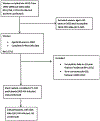Improved fracture prediction using different fracture risk assessment tool adjustments in HIV-infected women
- PMID: 29762165
- PMCID: PMC6126899
- DOI: 10.1097/QAD.0000000000001864
Improved fracture prediction using different fracture risk assessment tool adjustments in HIV-infected women
Abstract
Objectives: A fracture risk assessment tool (FRAX) using clinical risk factors (CRFs) alone underestimates fracture risk in HIV-infected men. Our objective was to determine whether accuracy of FRAX would be improved by considering HIV as a cause of secondary osteoporosis, and further improved with addition of dual-energy X-ray absorptiometry parameters in HIV-infected women.
Design: Subgroup analysis of Women's Interagency HIV Study.
Methods: We included 1148 women (900 HIV-infected and 248 uninfected) over age 40 with data to approximate FRAX CRFs and 10-year observational data for incident fragility fractures; 181 (20%) HIV-infected women had dual-energy X-ray absorptiometry data. Accuracy of FRAX was evaluated by the observed/estimated ratios of fracture in four models: CRFs alone; CRFs with HIV included as a cause of secondary osteoporosis; CRFs and femoral neck bone mineral density (FN BMD); and CRFs, FN BMD and trabecular bone score.
Results: FRAX using CRFs were less accurate in HIV-infected than uninfected women for major osteoporotic (observed/estimated ratio: 5.05 vs. 3.26, P < 0.001) and hip fractures (observed/estimated ratio: 19.78 vs. 7.94, P < 0.001), but improved when HIV was included as a cause of secondary osteoporosis. Among HIV-infected women, FRAX accuracy improved further with addition of FN BMD (observed/estimated ratio: 4.00) for hip fractures, but no further with trabecular bone score.
Conclusion: FRAX using CRFs alone underestimated fracture risk more in older HIV-infected women than otherwise similar uninfected women. Accuracy is improved when including HIV as a cause of secondary osteoporosis for both major osteoporotic and hip fractures, whereas addition of FN BMD only improved accuracy for hip fracture.
Conflict of interest statement
Conflicts of interest
There are no conflicts of interest.
Figures


Similar articles
-
Fracture Risk Indices From DXA-Based Finite Element Analysis Predict Incident Fractures Independently From FRAX: The Manitoba BMD Registry.J Clin Densitom. 2019 Jul-Sep;22(3):338-345. doi: 10.1016/j.jocd.2019.02.001. Epub 2019 Feb 8. J Clin Densitom. 2019. PMID: 30852033
-
Fracture Prediction With Modified-FRAX in Older HIV-Infected and Uninfected Men.J Acquir Immune Defic Syndr. 2016 Aug 15;72(5):513-20. doi: 10.1097/QAI.0000000000000998. J Acquir Immune Defic Syndr. 2016. PMID: 27003493 Free PMC article.
-
Prevalence of HIV-associated osteoporosis and fracture risk in midlife women: a cross-sectional study in Zimbabwe.J Bone Miner Res. 2024 Sep 26;39(10):1464-1473. doi: 10.1093/jbmr/zjae138. J Bone Miner Res. 2024. PMID: 39180721 Free PMC article.
-
Bone density measurement and assessment of fracture risk.Clin Obstet Gynecol. 2013 Dec;56(4):667-76. doi: 10.1097/GRF.0b013e3182a8ad7e. Clin Obstet Gynecol. 2013. PMID: 24022502 Review.
-
Primary care use of FRAX: absolute fracture risk assessment in postmenopausal women and older men.Postgrad Med. 2010 Jan;122(1):82-90. doi: 10.3810/pgm.2010.01.2102. Postgrad Med. 2010. PMID: 20107292 Review.
Cited by
-
Osteoporosis and HIV Infection.Calcif Tissue Int. 2022 May;110(5):624-640. doi: 10.1007/s00223-022-00946-4. Epub 2022 Jan 30. Calcif Tissue Int. 2022. PMID: 35098324 Free PMC article. Review.
-
Bone Mineral Density and Trabecular Bone Score Changes throughout Menopause in Women with HIV.Viruses. 2023 Dec 1;15(12):2375. doi: 10.3390/v15122375. Viruses. 2023. PMID: 38140615 Free PMC article.
-
Bone Health in People Living with HIV/AIDS: An Update of Where We Are and Potential Future Strategies.Microorganisms. 2023 Mar 19;11(3):789. doi: 10.3390/microorganisms11030789. Microorganisms. 2023. PMID: 36985362 Free PMC article. Review.
-
Cumulative Human Immunodeficiency Virus (HIV)-1 Viremia Is Associated With Increased Risk of Multimorbidity Among US Women With HIV, 1997-2019.Open Forum Infect Dis. 2022 Dec 28;10(2):ofac702. doi: 10.1093/ofid/ofac702. eCollection 2023 Feb. Open Forum Infect Dis. 2022. PMID: 36751648 Free PMC article.
-
The combined effects of age and HIV on the anatomic distribution of cortical and cancellous bone in the femoral neck among men and women.AIDS. 2021 Dec 1;35(15):2513-2522. doi: 10.1097/QAD.0000000000003061. AIDS. 2021. PMID: 34482349 Free PMC article.
References
-
- Compston J HIV infection and bone disease. J Intern Med 2016; 280:350–358. - PubMed
-
- Castronuovo D, Cacopardo B, Pinzone MR, Di Rosa M, Martellotta F, Schioppa O, et al. Bone disease in the setting of HIV infection: update and review of the literature. Eur Rev Med Pharmacol Sci 2013; 17:2413–2419. - PubMed
-
- Battalora L, Buchacz K, Armon C, Overton ET, Hammer J, Patel P, et al. Low bone mineral density and risk of incident fracture in HIV-infected adults. Antivir Ther 2016; 21:45–54 - PubMed
-
- Young B, Dao CN, Buchacz K, Baker R, Brooks JT, Investigators HIVOS. Increased rates of bone fracture among HIV-infected persons in the HIV Outpatient Study (HOPS) compared with the US general population, 2000–2006. Clin Infect Dis 2011; 52:1061–1068. - PubMed
Publication types
MeSH terms
Grants and funding
- U01 AI103397/AI/NIAID NIH HHS/United States
- U01 AI031834/AI/NIAID NIH HHS/United States
- U01 AI035004/AI/NIAID NIH HHS/United States
- R01 AI095089/AI/NIAID NIH HHS/United States
- U01 AI034989/AI/NIAID NIH HHS/United States
- UM1 AI069470/AI/NIAID NIH HHS/United States
- U01 AI034994/AI/NIAID NIH HHS/United States
- U01 AI103401/AI/NIAID NIH HHS/United States
- U01 AI103408/AI/NIAID NIH HHS/United States
- U01 AI103390/AI/NIAID NIH HHS/United States
- U01 AI034993/AI/NIAID NIH HHS/United States
- P30 AI050410/AI/NIAID NIH HHS/United States
- U01 HD032632/HD/NICHD NIH HHS/United States
- U01 AI042590/AI/NIAID NIH HHS/United States
LinkOut - more resources
Full Text Sources
Other Literature Sources
Medical
Miscellaneous

